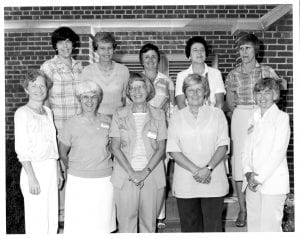Post Author: Jacob Houser

In the 1950s and 1960s, there was a movement for more organization for collegiate women’s athletics, mainly to provide for more opportunities to play and compete formally. Before Title IX, action was already being taken to improve women’s sports, by forming a governing body that would help organize women’s sports, namely the Association for Intercollegiate Athletics for Women (AIAW). As shown before, women’s and men’s sports were treated very differently, with the men receiving both more funding and coverage via television and other outlets. Women were much more limited in their athletic endeavors.
Dr. Morrison, a former professor and coach at Madison College/James Madison University as well as a founder and one time president of the AIAW, remembered that, “None of the conferences, leagues, nor national athletic organizations was providing any leadership or competitive participation to women.” (Struggle, 2). According to the 1975- 1976 AIAW Handbook-Directory, the commission established national championships for women’s sports and encouraged the organization of women’s sports at all levels, including local, state and regional (AIAW Handbook, 1).
It is first important to understand how the AIAW came to be. The movement really began not with students, but with the professors and coaches at a few colleges, Madison College included. According to Dr. Morrison,
“In the 60s and 70s PE women in some of the colleges (NAGWS women and others) questioned the fact that we had limited opportunities for girls and women to participate in competition and to find out how good they could be. I remember as an undergraduate being required to take part in intramurals as a P.E. major- we had no sports teams- and finding that experience was no challenge” (AIAW History, 1)
According to Morrison’s history of the AIAW, she and some other Virginians began to form a regional organization that would represent southern schools, from Virginia to Texas. A meeting was called and at that meeting the AIAW was organized. The goal of the AIAW was laid out in the AIAW handbook. It says that “Colleges and universities are encouraged to actively support the AIAW through membership if (1) they subscribe to the belief that the focus of women’s intercollegiate athletics should remain on the individual participant in the primary role as college student.” (AIAW Handbook, 1) It is important to note in that statement the focus on women as students rather than as athletes representing the school, a big difference between men’s and women’s sports at the time.
The new organization expanded quickly and soon sponsored 961 schools. By the late 1970s, it had even secured a television contract, thus drawing the ire of the NCAA, the governing body for men’s sports. Morrison describes the AIAW as a threat to the NCAA because of its growing success and popularity. From the beginning, some leaders in the AIAW wanted to join the NCAA because they felt it would be good to have a united governing body for both men’s and women’s sports. Once the NCAA began to offer championships for women, many schools left AIAW for the NCAA. The AIAW was disbanded in 1982. Morrison wrote of the decision,
“After much discussion the board of the AIAW decided to disband rather than see women in athletics split and we negotiated with the NCAA to secure leadership opportunities in the NCAA for women. It was a difficult decision because we had representation from three different collegiate groups and we were leaving two of those groups which had been an important part of AIAW” (AIAW History, 2).
Madison College/ James Madison University had the honor and privilege to have Dr. Morrison on its staff during this pivotal time in the nation for sports. Her pioneering work with the AIAW shows that Madison College had an impact on the organization of women’s sports and is thus a pioneer in women’s sports nationally.
Works Cited:
AIAW Handbook-Directory 1975-1976. Washington, D.C., 1975.
Image of AIAW Executive Board, 1979. Lee Morrison Papers, Special Collections, Carrier Library, James Madison University, Harrisonburg, Virginia.
Morrison, Leotus. “AIAW History (1970-1982).” 1-3, Lee Morrison Papers, Special Collections, Carrier Library, James Madison University, Harrisonburg, Virginia.
Morrison, Leotus. “The Struggle In Women’s Athletics.” November 12, 1974: 1-15, Lee Morrison Papers, Special Collections, Carrier Library, James Madison University, Harrisonburg, Virginia.
